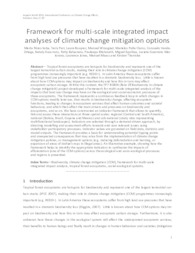Framework for multi-scale integrated impact analyses of climate change mitigation options.
Framework for multi-scale integrated impact analyses of climate change mitigation options.
Author(s): PÉREZ-SOBA, M.; PARR, T.; WINOGARD, M.; CLAROS, M. P.; VARELA-ORTEGA, C.; ASCARRUNZ, N.; BALVANERA, P.; BHOLANATH, P.; EQUIHUA, M.; MARTORANO, L. G.; JONES, L.; MAASS, M.; THONICKE, K.
Summary: Tropical forest ecosystems are hotspots for biodiversity and represent one of the largest terrestrial carbon stocks, making their role in climate change mitigation (CCM) programmes increasingly important (e.g. REDD+). In Latin America these ecosystems suffer from high land use pressures that have resulted in a dramatic biodiversity loss. Little is known about how CCM options may impact on biodiversity and how this in turn may affect ecosystem carbon storage. Within this context, the FP7 ROBIN (Role Of Biodiversity In climate change mitigatioN) project developed a framework for multi-scale integrated analysis of the impacts that land use change may have on the ecological and social-economic processes of these ecosystems. The framework represents a continuous feedback loop in which changes in CCM options modify land use, that results in biodiversity change, affecting ecosystem functions, leading to changes in ecosystem services that affect human outcomes and societal behaviour, and which then affect the main drivers and pressures on biodiversity and ecosystems, and so on. We have constructed an indicator framework that allows to quantify, link and assess these interactions at three spatial scales: regional (Central and South America), national (Bolivia, Brazil, Guyana and Mexico) and sub-national (study sites representing multifunctional landscapes). Indicators are selected through a demand-driven approach, by directing modelling and assessment efforts towards end-user relevant issues using stakeholder participatory processes. Indicator values are grounded on field data, statistics and model outputs. The framework provides a basis for understanding potential tipping points and unexpected consequences that may arise from the implementation of climate change mitigation policies, or management options (e.g. reducing deforestation and burning, or expansion of areas of biofuel crops in illegal areas) . An illustrative example, showing how the framework helps to identify the appropriate indicators to synthesise the impacts of afforestation (one of the CCM options) across the ecological and socio-ecological processes and regions is presented
Publication year: 2013
Types of publication: Paper in annals and proceedings
Unit: Embrapa Eastern Amazon
Keywords: Biodiversidade, Ecossistema, Floresta Tropical, Mudança Climática
Observation
Some of Embrapa's publications are published as ePub files. To read them, use or download one of the following free software options to your computer or mobile device. Android: Google Play Books; IOS: iBooks; Windows and Linux: Calibre.
Access other publications
Access the Agricultural Research Database (BDPA) to consult Embrapa's full library collection and records.
Visit Embrapa Bookstore to purchase books and other publications sold by Embrapa.

